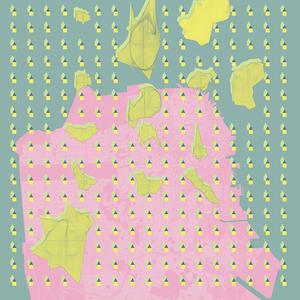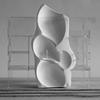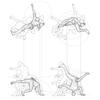This studio grapples with problems related to the integration of physical and digital form-finding techniques into creative architectural design. Embracing the schema of the formal design experiment, we seek to resolve the authoritative voice that is so often bestowed upon the results of form-finding processes with the traditional authorial voice of the designer. We will do so through a series of formal material experiments that undermine the uncompromising and imperative voice, and replace it with one of a range of potential alternatives: double, foil, doppleganger, collaborator, trickster, confederate, and enemy.
Working through the design and execution of experiments both physical (using plaster, rubber, air, gravity, and pressure) and digital (using Grasshopper and Kangaroo) material experiments, we will:
- Seek to reconfigure our relationship with the products of form-finding, thereby undermining the authoritative voice typically ascribed to them.
- Remain mindful of the contrived nature of form-finding experiments, and maintain an awareness they each only accounts for a limited subset of design concerns.
- Pursue and seize opportunities for creative authorship offered by both the form-finding and the compositional models. We will act both as active designers of experimental situations, and unrestrained interpreters of the forms that result.
Background
Physical form-finding, sometimes referred to as "material computation" describes a design approach that makes active use of specific properties of physical materials in the service of calculating architectural form. While this approach has historically been executed via experiments with physical materials, it can also be conducted using digital simulations of material behavior. We see such methods reflected in a range of minor movements and experimental practices - from the ground-breaking experiments of Gaudi and Otto, to the agent-based emergent approaches of Frazer and Testa, to hyperbolic and at times histrionic parametricism of Schumacher, to the morphogenetic design ideas articulated by Oxman and Menges. For these designers (and also for our purposes) the media of these methods matter less than their inherent behavior. The physical and the digital are thereby interchangeable, as, for example, the dynamic relaxation of connected particles in a Kangaroo model is effectively equivalent to the resolution of tensile forces in weights hung by chains found in Gaudi's model.
Not all architects accept form-finding as a valid approach to design. This is largely due to the resistances presented by form-finding techniques to the core approach of the traditional model of architectural design: composition. As architecture has historically been positioned as a synthetic practice, it centers on the the ability of the designer to make conceptual leaps that connects disparate sets of demands, and unites seemingly unrelated orders. In contrast, the form-finding model of design is widely seen as primarily analytical. It hinges not on any interior capacity of an individual designer, but on the efficacy of a carefully-crafted design experiment to appropriately model some aspect of a useful architectural reality. Despite this tension, these two approaches are not mutually exclusive, nor is an attempt at their resolution entirely new. We may observe that over the past century, robust cultures of practice that employ different combinations of form-finding and composition have flourished.
Notably, despite the significant differences between them, we may also observe that cultures that employ both form-finding and composition share a metaphor for the relationship between designer and the artifacts of design thinking. We can see this metaphor at work in that way that compositionally motivated architects often personify the artifacts of design production, speaking of what a drawing is "saying", or noting that a model "wants to be" some other way. While its proponents might not characterize it in such a way, a similar authority is bestowed upon physical artifacts in form-finding circles. This is evidenced by the fact that, while the assumptions of any given experiment might be called into question, a valid experimental procedure is regarded as authoritative, and it would be considered "cheating" to alter the results of such an experiment in any way. In each case, the practitioners of these methods find it useful to imagine that the artifacts of design thinking themselves have a voice, and function as an active participant in the process of design. Understanding this role of the artifacts of design as an "other", one that is serviceable to the designers that wield them, offers us the key to understanding the challenges associated with integrating form-finding techniques in creative architectural design. To be effective, compositional design relies upon a specific set of qualities in the artifacts it employs. Drawings are models are most useful when they exhibit just the right amount of ambiguity: they should be concrete enough as to suggest a new order that we might not have otherwise considered, and yet flexible enough as to allow us to project new orders into them as we see fit. Compositional designers seek in their representations good partners for conversation - affable, engaging, and generous - qualities that are too often overlooked by the more stoic cultures of practice engaged in form-finding. The experiments associated with form-finding design techniques are too often regarded as necessarily generative of unmodifiable answers to design questions. When taken is such a rigid way, they are ineffective partners in the conversation required for productive design thinking.
Aims
This observation leads us to the position of this studio, and the rationale for its title "significant others". We recognize the value of the form-finding approach, but have diagnosed a flaw in how the artifacts of form-finding are regarded as a productive and significant "other" in the design process. Not satisfied with allowing these artifacts to rule over us with an uncompromising and authoritative voice, we will instead ascribe a range of other potential voices to these experiments. These might include voices such as double, foil, doppleganger, collaborator, trickster, confederate, and enemy.
-
We will seek to reconfigure our relationship with the products of form-finding, thereby undermining the authoritative voice typically ascribed to them.
-
We will remain mindful of the contrived nature of form-finding experiments, and will maintain an awareness they each only accounts for a limited subset of design concerns.
-
We will pursue and seize opportunities for creative authorship offered by both the form-finding and the compositional models. - We will act both as active designers of experimental situations, and active interpreters of the forms that result.
-
Drawing liberally from the rich history of the practice, we will enthusiastically embrace a range of form-finding strategies, both physical and digital, and seek to repurpose these methods to a set of ends distinctly different from their typical application.



